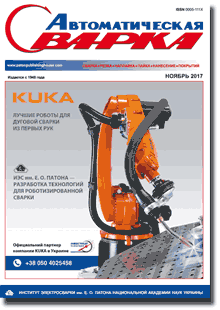| 2017 №11 (02) |
DOI of Article 10.15407/as2017.11.03 |
2017 №11 (04) |

Avtomaticheskaya Svarka (Automatic Welding), #11, 2017, pp. 25-30
Selection of technology for repair welding of parts of turbine units
A.K. Tsaryuk1, V.P. Elagin1, G.A. Rozumenko2, A.I. Pasechnik3 and V.A. Peretyatko4
1E.O. Paton Electric Welding Institute of the NAS of Ukraine 11 Kazimir Malevich Str., 03150, Kiev, Ukraine. E-mail: office@paton.kiev.ua
2Zmiyevskaya heat power plant Slobozhanskoye vil., 63460, Zmiyev district, Kharkov region, Ukraine. Е-mail: сsto_zm.tes@der.com.ua
3OJSC «Energoinvest» 19 Geroev truda Str., 84500, Bakhmut, Ukraine. Е-mail: а.pasechnik@der.com.ua
4PJSC «Tsentrenergo» 120/4e Kazatskaya Str., 03680, Kiev, Ukraine. Е-mail: peretyatkovladimir@ukr.net
Abstract
The peculiarities of disassembly-free repair of steel grade 15Kh1M1FL body of the control valve of the medium pressure cylinder of the turbine PT-200-130 of the heat power plant, in which a crack was formed after a long-term service, are given. The repair without disassembly of the valve is possible due to the use of technology of repair arc welding by pearlite electrodes with preheating and thermal recovery. 12 Ref, 1 Table, 7 Figures.
Keywords: crack, case, steel 15Kh1M1FL, repair welding, thermal metal recovery
Received: 10.10.17
Published: 06.12.17
References
- Gladshtejn, V.I. (2014) Microdamageability of metal of high-temperature parts of power equipment. Moscow, Mashinostroenie [in Russian].
- Chernousenko, O.Yu. (2013) Damage and residual life of stop valves of high- and medium-pressure cylinders of steam turbine K-800-240 of Slavyansky thermal power station. Visnyk NTU KhPI. Series: Power and thermotechnical processes and equipment. Kharkiv, 986(12), 100–106 [in Russian].
- Anokhov, A.E., Korolkov, P.M. (2003) Welding and heat treatment of case power equipment in repair. Kiev, Ekotekhnologiya [in Russian].
- Khromchenko, F.A. (2005) Welding technologies in repair works. Moscow, Intermet Engineering [in Russian].
- Lipodaev, V.N., Snisar, V.V., Elagin, V.P. et al. (1991) Peculiarities of brittle fracture of dissimilar welded joint with high-nickel weld metal. Svarka, 10, 6–9 [in Russian].
- STO TsKTI 10.049–2013: Removal of defects in cast parts of power equipment using welding without subsequent heat treatment [in Russian].
- Efimenko, N.G., Atozhenko, O.Yu., Vavilov, A.V. et al. (2014) Structure and properties of welded joints of 15kh1M1FL steel at repair of casting defects by transverse hill method. The Paton Welding J., 2, 42–46. https://doi.org/10.15407/tpwj2014.02.06
- Tsaryuk, A.K., Ivanenko, V.D., Volkov, V.V. et al. (2009) Repair welding of turbine case parts from heat-resistant steels without subsequent heat treatment. Ibid., 12, 32–36.
- Tsaryuk, A.K., Ivanenko, V.D., Skulsky, V.Yu. et al. (2012) Technology of repair welding of boiler unit assemblies without postweld heat treatment. Ibid., 9, 37–43.
- Kozlov, R.A. (1969) Hydrogen in welding of hull steels. Leningrad, Sudostroenie [in Russian].
- Aloraierd, A., Al-Maznoueed, A., Price, J.W.H. et al. (2010) Weld repair practices without post weld heat treatment for ferritic alloys and their consequences on residual stresses. J. of Pressure Vessels and Piping, 87, 127–133. https://doi.org/10.1016/j.ijpvp.2010.02.001
- Som Dutt Sharma, S.D., Saluja, R., Moeed, K.M. (2013) A review on effect of preheating and/or post weld heat treatment. (PWHT) on hardened steel. J. of Techn. Research and Applications, 1(Issue 2), 5–7.
